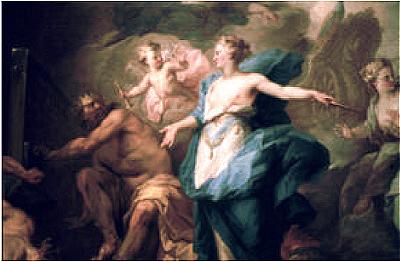Juno commands Aeolus to release the winds
SN 374, oil on canvas. 1735
J. D’Audenaerde
French, active in Lille From "The Pages"
ARTIST:
D’Audenaerde of Lille, France, is mentioned in a guide published in 1772, and another
author mentions a painting of his, “Deposition of Christ.” He is thought to
belong to Charles Antoine Coypel’s circle of friends, but nothing more is known about
his life.
SUBJECT:
The scene is taken from Virgil’s Aeneid, Book I, v. 50. Juno hated neas and his
Trojan followers - particularly Paris, Prince of Troy; she was consumed by jealousy
because he had chosen Helen as being more beautiful than she. i.e. “Judgment of Paris
“ Gal. 9 |
|
 |
Juno had helped eolus, god of the winds, obtain his kingdom, so in turn olus agreed
to help her by creating a storm at sea….the winds were to destroy the Trojan fleet
headed for Italy. olus had married Aurora, Goddess of Dawn, who bore him 6 sons: Boreas,
north wind; Coros, northwest wind; Agrulo, west wind; Notos, southwest wind; Eurus, east
wind; and Zephyrus, south wind. Their father kept them confined in a cave, only letting
one at a time out to exercise – except for the gentle Zephyrus, who was free to roam
at will. I.e. Tiepolo’s “Aurora” Gal. 15
PAINTING:
Juno stands in the center in queenly pose, holding a scepter. She wears a blue garment and
a golden crown. Zephyr hovers by her right shoulder as olus holds the door of the cave.
On the left side of the painting, two of the sons stumble in their haste to get out.
Juno’s messenger, Iris, is a rainbow left by her swiftly moving robe. Juno’s
chariot bears her peacock symbol; a real peacock is at her feet. Nymphs pour water on the
ill-fated Trojan ships (see sail).
The composition is pyramidal, with pastel coloring. The figures are highly active,
gesturing, pouring, flying, tumbling….everything augurs change, which is typical of
18th c French Rococo painting.
HISTORIC CONTEXT:
D’Audenaerde is associated with circle of Charles Antoine Coypel, whose signature
appears on the Ringling painting “Madame de Bourbon-Conti.” Coypel painted in
the court of Louis XV, becoming First Painter in 1743, and Director of the French Academy
in 1747.
After the profligate reign of Louis XIV at Versailles, France’s financial coffers
were drained. Aristocrats and nobles moved to smaller Parisian townhouses, which had to be
decorated. Paintings and sculptures now needed to be much smaller. The style of
furnishings therefore became more intimate and comfortable. The collecting of porcelain
figurines, and the desire for elaborate table-settings for dinner parties, stimulated the
demand for hard-paste porcelain formulas. Factories were set up in France and Germany to
produce porcelain which emulated the Chinese imported wares.
Works by Rosalba Carriera, the pastel portraitist, became highly desirable. The whole 18th
c scene in France became a setting of light, filled with movement and wit. The desire for
the French style of dress, food, and furnishings spread, promoted by French artists
abroad, or foreign artists studying in Paris.
ringlingdocents.org
|
